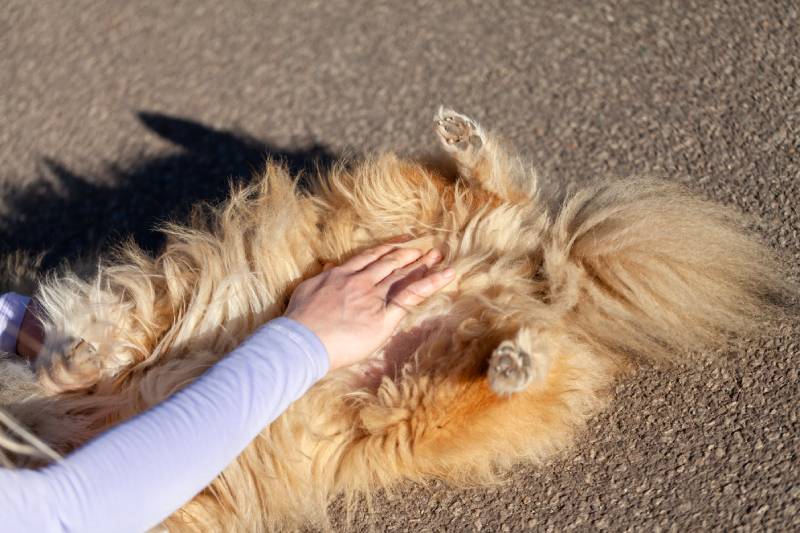12 Sounds Your Dog Makes & Their Meaning (With Video Examples)

Updated on

Everyone knows what a dog means when they growl or bark, and it’s no mystery why they’re grunting when you scratch that spot behind their ears.
Those are far from the only sounds your dog is capable of making, though, and some of them can be quite hard to decipher. What does that weird honking sound they sometimes make mean? Why are they howling? Are there other sounds a dog makes? And how can you make them stop?
Below, we’ll explore common sounds that dogs make, as well as go over possible meanings behind the noises.
The 12 Sounds a Dog Makes & What They Mean
1. Dog Barking
Barking is probably the most common sound that a dog makes, and there are a variety of reasons that they make it. That’s why it’s one of the hardest behaviors to curb, as you have to understand why your dog’s barking before you can get them to stop.
Dogs will bark to alert you to danger or out of fear, boredom, stress, etc. Not all barks are bad, though. They also bark to get your attention or to let another dog know that it’s time to play.
As a general rule, the higher the pitch, the more distressed the dog is. You should pay attention to repetitive, high-pitched barks, as they indicate that your dog feels that something is seriously wrong.
Demand barks tend to be lower, sharper, and more persistent. They’ll also be clearly directed at the person or animal that the dog is demanding something from. Play barks, on the other hand, sound happy and lighthearted and are usually accompanied by a wagging tail and a play bow.
2. Dog Growling Sounds
Unlike barking, growling usually only signifies one thing: Watch out. It’s a dog’s way of warning you that they’re losing their patience with something you’re doing and that their next step will be to lash out.
As paradoxical as it may sound, though, growling is a good thing — or at least it’s better than the alternative. A dog who’s growling is giving you advance notice that they’re not happy, so you can change your behavior before you get attacked.
It’s far worse to have a dog that lashes out with no warning whatsoever. As a result, you shouldn’t punish your dog for growling; instead, address whatever behavior is causing them to growl.
There is one exception to the “growling is a bad sign” rule. Some pups will growl when they’re happy, like when they’re playing tug of war. This is especially common in bully breeds, and it can be quite nerve-wracking, as it’s hard to tell when to let your dogs play versus when to make them stop.
You’ll have to rely on your dog’s other behavioral cues for your answer. If their body is relaxed and there are no other signs of aggression, everything is probably fine. If, however, they start snarling, snapping, freezing up, or staring intently at the other dog, you should have them take a timeout.
- Related Read: 8 Types of Dog Growls: What Do They Mean? (with Audio)
3. Dog Grumbling Sounds
Grumbling sounds almost identical to growling, but it has a different meaning. Many dogs grumble out of pleasure, so you may hear it while you’re petting them. Some also grumble right before barking playfully.
The only real way to tell the noises apart is by context. If the dog is doing something enjoyable and not showing any other warning signs, it’s probably a grumble. If, however, they have bared fangs and raised hair and seem generally uncomfortable, you’re most likely dealing with a growl.
4. Dog Howling Sounds
Howling is a behavior that dogs inherited from their wolf ancestors. In the wild, wolves howl in order to find their pack if they become separated or as a social function to create a sense of belonging within the group. They’ll often howl together after a successful hunt, for example.
While they have things in common with their ancestors, dogs are not wolves. When they were domesticated, a greater emphasis was placed on teaching dogs to bark, as that behavior was more beneficial to humans because it warned of intruders.
Modern dogs rarely hunt and kill in packs, and they don’t need to howl to celebrate vanquishing the kibble that you poured into their bowl. As a result, howling has largely lost its social significance — but not entirely.
The fact is that most dogs will only howl if they hear other dog howling sounds or if they hear something that sounds like another dog howling (such as a siren or certain musical instruments). Lost dogs may also howl, which we assume is a sign that they desire to be reunited with their families.
Dog howling can also be a sign of separation anxiety, so if you hear your dog howling every time you leave the house, it’s their way of saying that they want to be reunited with their favorite pack member.
5. Dog Baying Sounds
Baying is similar to howling, except it sounds a bit different and has a quite different meaning.
Baying is an activity that’s solely reserved for hunting hounds. It’s a trait that was bred into them, as it’s a useful way for them to communicate with the humans in their hunting party if they get separated.
Whereas howling tends to take the form of one long, drawn-out note, baying increases in intensity the closer the hound gets to their prey. This lets the hunter know that the hound has cornered its quarry and that they’re simply waiting for the human to show up and finish the job.
Also, unlike howling, baying is designed to communicate with humans as much as other dogs. It’s an excited wail, and it’s intended to draw every species in the hunting party toward the baying dog as quickly as possible.
6. Dog Yelping Sounds
It’s important to note that the attached video is a close approximation of the sound that we’re talking about, but it’s not an exact match. The fact is, most of the videos we could find that featured a dog yelping were far too depressing to post here (don’t search for it — seriously).
Yelping is a sudden, high-pitched cry that indicates the dog has experienced something painful. Yelping is generally due to a specific action rather than a source of chronic pain.
For example, a dog won’t yelp due to arthritis in their back, but they may yelp if they do something that suddenly exacerbates that pain. They’ll also yelp at the moment that an injury occurs, like a hurt paw, but they’re unlikely to keep yelping after that.
As hard as it is to listen to, yelping can be useful for determining the cause or location of a dog’s injury. Many vets will palpate a dog’s body until the animal yelps; this helps them zero in on the offending body part.
Dogs may also yelp while playing to indicate to the other puppy that they’ve gotten too rough. This is an important social cue, and if the overexcited dog doesn’t back off immediately, you may need to get a professional trainer or behavioralist involved.
7. Dog Whimpering/Whining Sounds
Whimpering often goes hand-in-hand with yelping. Many dogs will yelp the instant that an injury occurs, then switch to whining to indicate their ongoing pain. They may also whimper if they’re in pain due to illness.
However, dogs will also whimper for reasons other than physical discomfort. Many whimper if they’re scared or anxious, and it’s not an uncommon sound in a vet’s office.
Some dogs whimper because they’re bored or want to get your attention. A dog may bring you a toy and then start whimpering if you don’t immediately start playing with them; this behavior is not unlike a child’s whining.
The only way to tell a pained whimper from a bored or anxious one is context. If your dog just yelped or is showing other signs of discomfort, the whimper is likely due to physical pain.
If, however, you’re in an unfamiliar situation or your dog is showing other attention-seeking signs, the whimper is more likely due to (real or imagined) emotional distress.
8. Dog Groaning/Sighing Sounds
Sighing and groaning are similar to the same behaviors exhibited by humans. Dogs will sigh to express contentment or displeasure, and you’ll have to rely on context clues to determine which is being conveyed at the time.
Many dogs will sigh as they tuck into their favorite napping spot for a siesta. They’ll also likely let out a groan of contentment if they curl up next to you and you start petting them. This means that life is good and you should keep doing what you’re doing.
If, however, your dog sighs and collapses on the floor because you told them you’re too busy to play fetch right now, it’s likely due to frustration. It’s a bratty, petulant behavior — and it’s pretty cute too.
9. Dog Coughing
Coughing is one of the most complex sounds that your dog can make. It could be the way that your dog chooses to relieve stress, or it could be a sign of a serious health problem.
Some dogs cough due to allergies, so if it seems to be a seasonal thing, you could just wait it out or ask your vet for help. Your dog may also cough because they drank water and it went down the wrong pipe, or they’ve got something stuck in their throat.
You should be concerned if the cough lasts longer than a week or is accompanied by fever or your dog refuses to eat. It’s also a concern if your dog seems more lethargic than normal or if the cough is just one of several symptoms.
There are quite a few diseases that could cause coughing, but below is a partial list. You’ll notice that many of these are quite intense, which underscores just how seriously you should take this particular sound:
- Heart disease
- Kennel cough
- Influenza
- Distemper
- Lung cancer
- Heartworms
- Fungal infections
10. Dog Snoring Noises
Just like in humans, snoring indicates that your dog is really enjoying their sleep. However, snoring can also be the sign of something more sinister.
Some dogs are more likely to snore than others. Brachycephalic breeds like Bulldogs and Boxers are notorious snoring machines, as they find it difficult to breathe under the best of conditions.
Certain dogs will only snore in a certain position or if their allergies are acting up. However, if the snoring suddenly gets much louder or more frequent, you may want to talk to your vet.
Snoring could mean that your dog is suffering from sleep apnea or hypothyroidism or that they’re simply overweight. It could also mean they have an abscessed tooth that’s blocking their nasal passages. Either way, it’s worth letting your vet have a look to rule out any serious issues.
11. Dog Reverse Sneezing Sounds
Sneezing is easily identifiable and usually harmless unless it’s accompanied by other symptoms. Reverse sneezing is something quite different, however.
The official name for reverse sneezing is “paroxysmal respiration,” and it occurs when dogs pull air through their nose and then push it right back out. It makes a strange snorting sound, as if your dog is trying to power through a regular sneeze.
Some dogs are more prone to paroxysmal respiration than others, and it can be triggered by environmental conditions like dust mites, pollen, or smoke. Breeds with long noses are more prone to the condition than others.
Reverse sneezing is generally harmless, but if it gets out of hand, your vet may prescribe medication to reduce the symptoms.
12. Dog Laughing
Believe it or not, dogs actually laugh just like we do. It doesn’t sound exactly the same, but it has a similar effect on the animal.
Dog laughter is also called “play panting,” and it’s a huh-huh-huh sound they make when they’re especially happy. It was discovered by animal researcher Patricia Simonet, who found that play panting has a different frequency than regular panting.
Not only that, but the sound also seems to have an inspiring effect on dogs, even if they’re not in on the joke. Simonet played sounds of dog laughter for pups in an observation room, each of whom would then grab a toy and look around for the laughing playmate. Playing sounds of dogs growling or other sounds elicited no reaction whatsoever.
If you can recognize or mimic dog laughter, you can take your play sessions with your pooch to the next level. As it turns out, laughter truly is contagious — no matter what species you happen to be.
Final Thoughts
Dogs are capable of a wide range of vocalizations, and each one seems to have a specific meaning. We haven’t learned what all those meanings are yet, but it’s fascinating to learn about all the ways that our pups try to communicate with us and each other.
Your dog may not make every sound on this list, but if you spend enough time around pooches, you’ll hear each of them sooner or later. Now if we could just teach dogs what we mean when we tell them “no.”
Featured Image Credit: Alexas_Fotos, Pixabay










